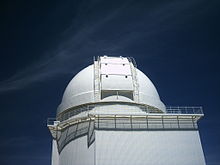- Calar Alto Observatory
-
Calar Alto Observatory Organization Max Planck Institute for Astrophysics,
Institute of Astrophysics of AndalusiaLocation Almería, Spain Coordinates 37°13′25″N 2°32′46″W / 37.22361°N 2.54611°W Altitude 2,168 m (7,113 ft) Webpage www.caha.es Telescopes telescope 3.5 m reflector telescope 2.2 m reflector telescope 1.5 m reflector telescope 1.23 m reflector telescope 0.8 m Schmidt reflector Asteroids discovered: 4 astronomical observatory owned and operated jointly by the Max-Planck-Institut für Astronomie (Max-Planck Institute for Astronomy) in Heidelberg, Germany, and the Instituto de Astrofísica de Andalucía (Institute of Astrophysics of Andalusia) in Granada, Spain. It is located in Almería province in Spain on Calar Alto, a 2,168-meter (7,113 ft) high mountain in Sierra de Los Filabres. Contents
History
The site was proposed in 1970, and was officially opened in July 1975 with the commissioning of its 1.2-meter (47 in) telescope. The site developed due German and Spanish cooperation in astronomy. Eventually 4 more telescopes were commissioned.
The Schmidt telescope was moved to Calar Alto in 1976 from the Hamburg Observatory at Bergedorf, where it had been completed in 1954.
Equipment
The Max-Planck institute owns a 3.5-meter (138-inch), 2.2 m (87 in), and a 1.23 m (48 in) telescope, and an 80 cm (31 in) Schmidt reflector. There is also a 1.5 m (59 in) telescope that is owned and operated by the Spanish (by the OAN).
References
- "Calar Alto Observatory homepage". Centro Astronómico Hispano Alemán. http://www.caha.es. Retrieved December 12, 2005.
External links
Coordinates: 37°13′14.85″N 2°32′47.67″W / 37.2207917°N 2.546575°W
Categories:- Astronomical observatories in Spain
- Asteroid discoverers (observatories)
Wikimedia Foundation. 2010.
Look at other dictionaries:
Calar Alto Observatory — Observatoire de Calar Alto Observatoire de Calar Alto Une des coupoles de l observatoire … Wikipédia en Français
List of observatory codes — Astronomical observatories are locations used for observing celestial events. Observatory codes are assigned by the Minor Planet Center (a service of the International Astronomical Union) for use in cataloguing astrometric observations of solar… … Wikipedia
Iraqi National Astronomical Observatory — Das Iraqi National Astronomical Observatory war eine geplante Sternwarte im Irak. Im Jahre 1982 wurden die deutschen Unternehmen Zeiss, Krupp und MAN beauftragt, eine Sternwarte auf dem Berg Mt. Korak im Nordirak in einer Höhe von 2600 Metern zu… … Deutsch Wikipedia
Ritchey-Chrétien telescope — The Ritchey Chrétien telescope or RCT is a specialized Cassegrain telescope designed to eliminate coma, thus providing a relatively large field of view as compared to a more conventional configuration. An RCT has a hyperbolic primary and a… … Wikipedia
Обсерватория Калар-Альто — купол 2.2 м телескопа Оригинал названия … Википедия
Instituto de Astrofísica de Andalucía — The Instituto de Astrofísica de Andalucía (Institute of Astrophysics of Andalusia, IAA CSIC) is an astrophysics related research institute funded by the High Council of Scientific Research of the Spanish government Consejo Superior de… … Wikipedia
NGC 7331 — Taken by Vicent Peris using the 3.5 meter telescope at the Calar Alto Observatory in southern Spain. Observation data (J2000 epoch) … Wikipedia
Meanings of minor planet names: 180,001–190,000 — As minor planet discoveries are confirmed, they are given a permanent number by the IAU s Minor Planet Center, and the discoverers can then submit names for them, following the IAU s naming conventions. The list below concerns those minor planets … Wikipedia
Igor Antón — Infobox Cyclist ridername = Igor Antón fullname = Igor Antón Hernández nickname = Fuji dateofbirth = birth date and age|1983|3|2 country = ESP height = height|m=1.73 weight = convert|59|kg|lb|abbr=on|lk=on currentteam = Euskaltel Euskadi… … Wikipedia
Meanings of minor planet names: 189001–190000 — As minor planet discoveries are confirmed, they are given a permanent number by the IAU s Minor Planet Center, and the discoverers can then submit names for them, following the IAU s naming conventions. The list below concerns those minor planets … Wikipedia

